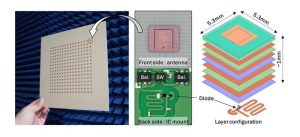Researchers have designed a novel wirelessly powered relay transceiver that improves 5G network coverage through efficient wireless power transmission and high power conversion efficiency.
This innovative design could enhance 5G network coverage even in places where links are blocked, improving flexibility and coverage area, and making high-speed, low-latency communications more accessible.
This study Proceedings of the 2024 IEEE MTT-S International Microwave Symposium.
Challenges in Implementing Widespread 5G Network Coverage
Millimeter wave 5G communication uses ultra-high frequency radio signals in the 24 to 100 GHz range and is expected to be the next-generation wireless communication technology that will enable high-speed, low-latency, and large-capacity networks.
However, there are two major challenges to the widespread coverage of 5G networks: first, low signal-to-noise ratio (SNR), while a high SNR is essential for good communication.
Another challenge is link blocking, where buildings or other obstacles disrupt the signal between the transmitter and receiver.
Beamforming has been used as a technique for long-distance communications using millimeter waves to improve SNR.
However, this is limited to line-of-sight communication, requires that the transmitter and receiver are in line with each other, and obstructions can degrade the received signal.
To address these issues, a team of researchers at the Tokyo Institute of Technology’s Future Interdisciplinary Research Institute for Advanced Science and Technology (FIRST) has designed a new wirelessly powered repeater transceiver for 28GHz mmWave 5G communications.

How Radio Transceivers Maintain a High SNR
Associate Professor Atsushi Shirane, who led the research, explains: “Wireless power supply does not require a dedicated power source, but because of its low conversion gain, many rectifier arrays are required to maintain the SNR, and they use CMOS diodes with a power conversion efficiency of less than 10%.
The proposed transceiver consists of a 256 rectifier array with 24 GHz wireless power transfer (WPT).
In particular, the transceiver is capable of simultaneous data and power transmission, converting 24 GHz WPT signals to direct current (DC), and achieving simultaneous bidirectional transmission and reception at 28 GHz.
The 24 GHz signal is received by each rectifier separately, while the 28 GHz signal is transmitted and received using beamforming.
Both signals can be received from the same or different directions, and the 28 GHz signal can be retro-reflected off the 24 GHz pilot signal or transmitted in any direction.
Test results reveal that the proposed transceiver can achieve 54% power conversion efficiency and -19 dB conversion gain, higher than conventional transceivers, while maintaining SNR over long distances.
“The proposed transceiver can contribute to the deployment of mmWave 5G networks even in places where links are blocked, improving installation flexibility and coverage area,” Shirane said.


